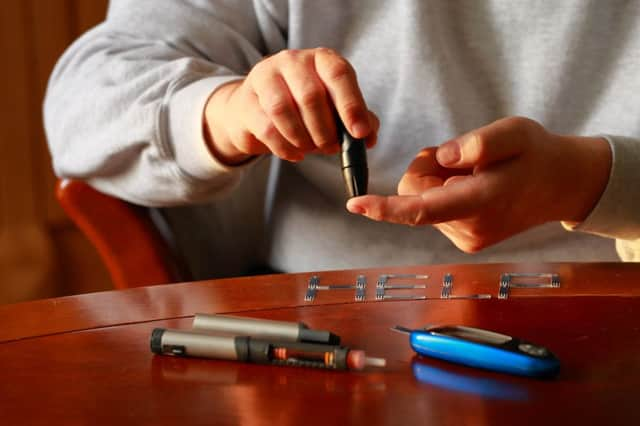Christine Jardine: I was a diabetic for a week – it’s a bloody nightmare


I also have a very close friend who has type 1 diabetes and I’d watched closely how she did it. I’d be fine.
Or so I thought.
Within 48 hours of starting my experiment in “living with diabetes” for Diabetes UK’s Awareness Week I was at my wits’ end.
Advertisement
Hide AdAdvertisement
Hide AdIn a real situation, I would probably also be in serious medical trouble. To explain, this is not a series of classroom talks, or a lot of reading about what diabetes is and the dangers of not having a working pancreas. No.
This is actually about trying to cope with the day-to-day routine and lifestyle demanded if you have to use insulin and a balanced diet to prevent your own immune system killing you.
You have to go through the experience of taking the blood tests, doing the injections and learning how to respond when the organisation sends you a text to say that something is wrong.
The point of the exercise is to draw attention to the challenge that currently faces more than 4.7 million people in this country who are living with diabetes.
It is the fastest growing and potentially most devastating health crisis we face, with around 700 people diagnosed in the UK every day.
Although I was learning about type 1, the fastest growth is in type 2 where being overweight or obese creates the greatest risk of developing the condition.
My week started with an introductory talk by a diabetic nurse, Dan.
For the first hour or so he took us through the sort of discussion we would have if we were one of his patients experiencing the trauma of a diagnosis.
Advertisement
Hide AdAdvertisement
Hide AdMuch of it was like a science class as he outlined how the lack of a fully functioning pancreas affects the glucose in our blood and what the personal impact might be.
It was when he gently informed us that if this were a real situation, he would now be holding our hands and comforting us, that what he was saying sank in.
Being told at any age that you will have to worry about potentially losing your sight, or a limb, is tough.
But more often than not with type 1 diabetes, the person who is hearing what they have in store is a teenager being told that because they were born with a faulty pancreas they now face a threat that will never go away.
As Dan went on to explain how we would need carbohydrate with every meal, would also need the correct amount of insulin to tackle it, and we would have to calculate the amount ourselves, I began to realise this might be very different from I imagined.
By the time we got to how to take a pinprick blood sample and give ourselves injections, I was overwhelmed.
Next morning I started my routine and within two hours hit an obstacle.
We were texted to say that because of hurrying and miscalculating our insulin our blood sugar was too low.
Advertisement
Hide AdAdvertisement
Hide AdThat is called a hypo. We would have to stop what we were doing immediately, rest, and take some fast-acting sugar like sweets or high sugar drink.
I couldn’t have. I was sat in a televised parliamentary select committee and hadn’t brought the emergency snacks Dan had told us we would need.
Of course, I didn’t have to worry, but in a real situation I was now in trouble.
I couldn’t get up and walk to the nearest shop. The energy that took would use vital sugar.
At the same time just sitting waiting is no use. It could only get worse unless I could get sugar.
That was blood-related though. The next day I made a very human mistake.
I confidently sat down to take my blood before lunch, calculated the amount of insulin I would need and reached into my bag for my syringe.
It wasn’t there. A simple mistake. But with this, I realised simple errors can be dangerous.
Advertisement
Hide AdAdvertisement
Hide AdImagine I had been on a train home to Edinburgh or worse still had gone for a day trip into the country, or even a weekend away. I would have been in serious trouble.
I was now beginning to realise what diabetics are up against.
That is before we talk about the regular appointments and retinal scans, the tests, the changes in regimen if you are finding that your blood levels aren’t responding.
All I could think was that, if this is what life is like, where is the respite?
I wasn’t surprised to learn that seven out of 10 people with diabetes suffer from mental health problems as a result of that never ending, underlying threat. I was doing this without any implications for my health.
Even so, I could see how the stress of knowing that you are twice as likely to have a heart attack or stroke and 20 times more likely to have an amputation would take a heavy toll of your emotions.
Today is my last day of what has been an astonishing, and in some ways life-changing, experience.
Tomorrow I will return my blood monitor, syringe, needles and diary of the week to Dan. I got into this to raise public awareness of a condition that I have watched someone I care about deal with on a daily basis.
Advertisement
Hide AdAdvertisement
Hide AdI was already aware of the long term issues and the relentlessness of it all.
But realise now that I wasn’t seeing the whole picture.
I never expected for a moment that the person whose awareness would be raised the most would be me.